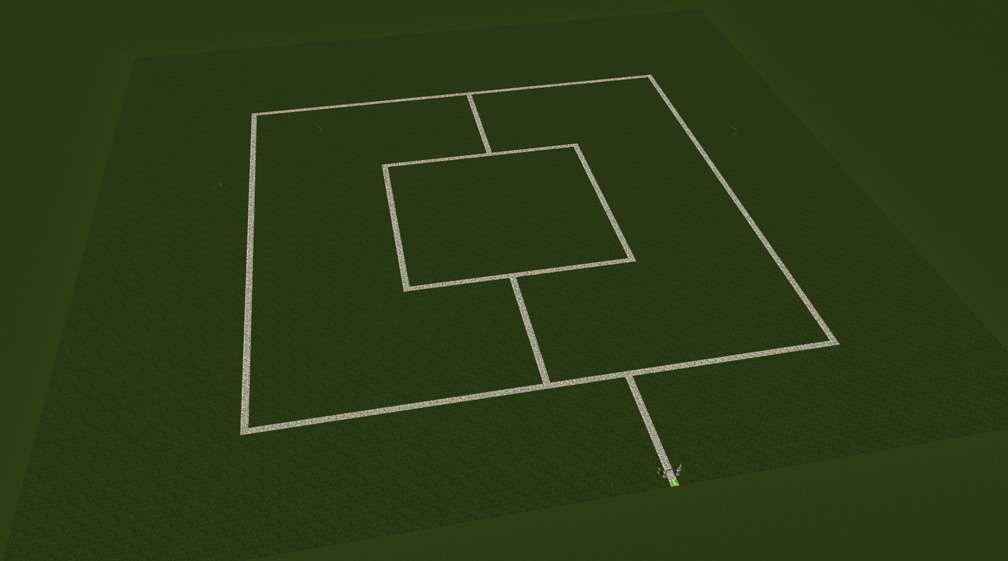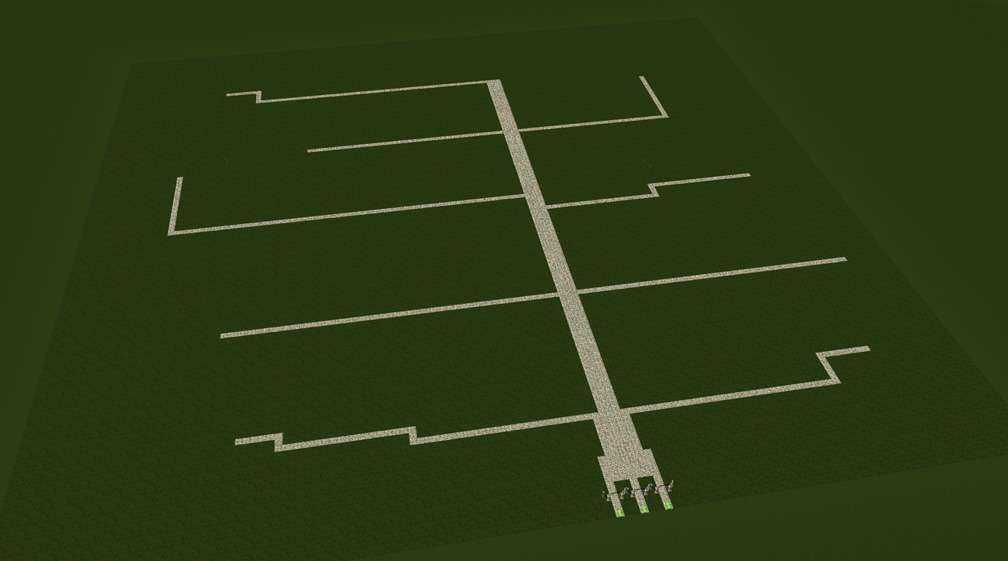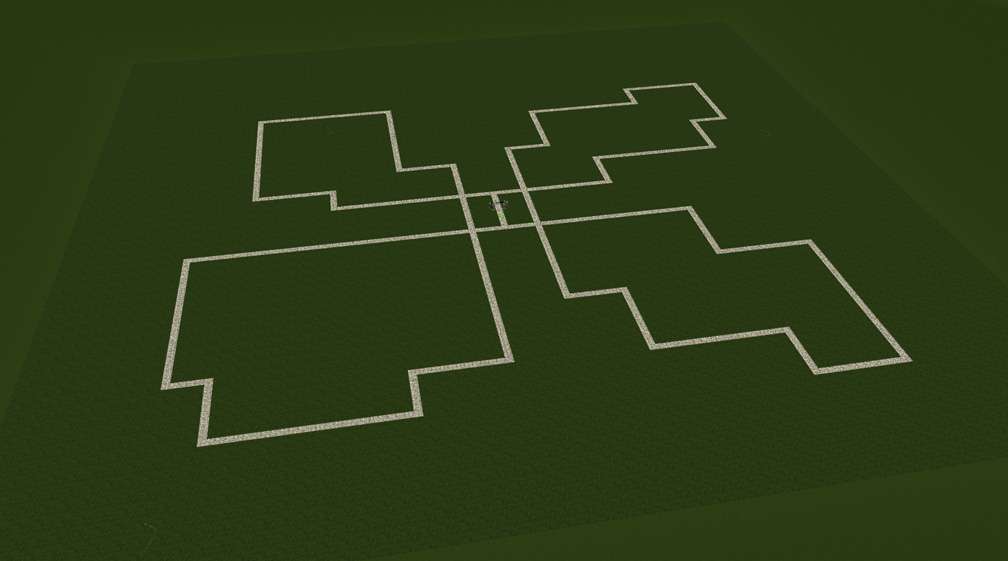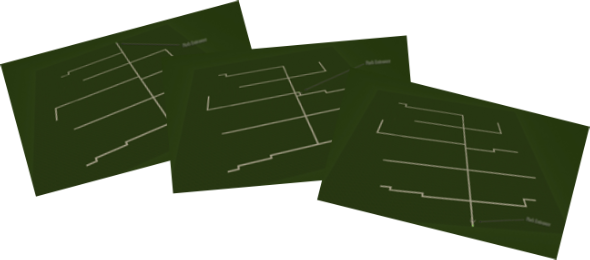|
Park Layout
|
|
|
|
|
|
|
|
How our guests get around our park is the foundation of our park's layout. The cornerstone of this is an arrangement of paths and queues that enables our park guests to flow smoothly throughout our parks while at the same time making it convenient for them to visit all our rides and attractions.
|
|
|
|
|
|
|
|
The path system is usually the first thing we add to our parks after we've terraformed the landscape. After their initial placement and during our park's development, quite often we'll remove, replace, and re-arrange some of our paths before we're satisfied with where the layout of our park is headed. When situating our park paths we should right at the start consider the style in which we want to arrange our walkways.
|
|
|
|
|
|
|
|
We can set up our paths so they make a circuit around the landscape.
|
|
|
|
|
|
|
|

|
|
As we can see from all that space in the center of the park, the single circuit layout is best for or small to medium sized parks. If we'd like this same sort of layout in medium- to large-sized parks we'd want to add inner circuits.
|
|
|
|
|
|
|
|
This next image displays a multi-circuit layout with two circuits but we may add as many inner circuits as we wish.
|
|
|
|
|
|
|
|

|
|
Alternatively, midway-type path systems can be created. This style features walkway offsets from the main throughway.
|
|
|
|
|
|
|
|

|
|
The midway path arrangement lends itself particularly well to multiple entrances along with multiple-width paths.
|
|
|
|
|
|
|
|

|
|
This style can easily be enhanced with multiple plazas.
|
|
|
|
|
|
|
|

|
|
Another path layout option is to center our park entrance and arrange the paths around it like the points of a star. In this example the 'star' has four points.
|
|
|
|
|
|
|
|

|
|
We can combine the star layout with an offset path layout for something entirely different.
|
|
|
|
|
|
|
|

|
|
It is better to decide before placing too much into our parks which of these path layout styles we'd like to use.
|
|
|
|
|
|
|
|
Whether straight or curved it doesn't make any sense to put paths all over the place anticipating that only a few strategically placed no entry signs will get the guests to cover all the paths we've created, nor will eliminating our guest injection point or increasing the number of them do the trick.
|
|
|
|
|
|
|
|

|
|
An excess of paths and lots of intersections in a medium-sized park such as in the illustration above will necessitate more path extras and more staff which mean more of a drain on the game engine and less of the other things we can get into the park for our better enjoyment. At-a-glance one might think that such a path system would ensure guests could easily get to all areas of the park. However, once they've decided where they want to go, guest AI directs that park guests take the shortest route to their desired location which means that the more paths that are placed the more paths there are for the guests to ignore.
|
|
|
|
|
|
|
|
In medium to small parks repeated intersections should be used minimally. Chained path intersections should only be used to outline huge swathes of terrain in the largest of parks but even then, without the careful placing of our attractions up to half of all the paths placed in such an arrangement could be ignored by the Guest AI.
|
|
|
|
|
|
|
|
The only sensible way to get guests to travel over all the paths in our park is to space coasters, rides, and attractions evenly about the park. This will enable the minimal use of one way signs throughout our park only at points where they're really needed. Without taking care to spread our attractions, maximum placement of no entry signs would be required to control access through every park path. Along with this we'd need a guest injection point & a park entrance (if our park does not already have them) which will ensure one-way travel throughout our park. This overkill approach will result in guests that don't look particularly natural all walking in the same direction although they will be spaced evenly about our park. In very large parks this method will also ensure that by the time our guests travel around the entire circuit to reach the park entrance so they can leave our park they'll be completely jaded with their park visit. So that such guests will leave our parks with an improved view of it and to offset the inevitable state of exhaustion experienced by guests in the latter half of such a path layout circuit it's essential that plenty of entertainers, stalls, facilities, benches, and toilets are made available throughout the second half of their journey around our park.
|
|
|
|
|
|
|
|
Making Our Park Attractive
|
|
|
|
|
|
|
|
Providing a huge infrastructure of paths in and of itself does not draw huge numbers of guests nor does it really add any appeal to the park. Park landscapes in which only the paths have been built will usually generate a trickle of arrivals until the park reaches its maximum guest attraction level of around one hundred guests. Increasing the size of the park, adding to the number of paths, and lowering the admission price does nothing to alter this.
|
|
|
|
|
|
|
|
Oddly, while there's nothing but paths in the park, at the default £50 average cash per guest we'll have no trouble setting the park's admission price to £50 and attracting guests who'll happily pay what we've asked to enter the park provided they're carrying that amount when they arrive at our park entrance. Again, because there's nothing in this park but paths we're restricted to the guest attraction value of around a hundred. All of us want more than a hundred guests in our parks and would prefer to charge more than £50 for park admission and the only way to accomplish this is to put more into our parks.
|
|
|
|
|
|
|
|
Guests are drawn to our parks by rides & attractions while it is our stalls & facilities that will encourage them to stay. Thusly, calculating the amount that can be charged for park admission beyond £50 starts out based on the number of rides & attractions and stalls & facilities that are included in our park - and needs to be below the amount of cash the guest is carrying when he arrives at our park entrance. When playing RCT3's official Campaign Scenarios in which we may choose the park's admission it's a good idea to find out what the average cash per guest is before deciding on how much we're going to charge for for guests to enter that park. You may find the average cash per guest that comes with each of the official Campaign Scenarios here.
|
|
|
|
|
|
|
|
Above admission prices of £50 we should strike a balance between building attractive parks that draw the guests to our park entrance along with admission prices that are reasonable enough in relation to what's included in the park so that new arrivals don't hesitate to pay what we're asking to enjoy a visit with us.
|
|
|
|
|
|
|
|
Each ride & attraction and stall & facility added to our park ultimately increases its maximum guest attraction level in addition to raising the potential of our admission price. Just like in real life, in RCT3 we need to spend money on our parks in order for our parks to make money for us.
|
|
|
|
|
|
|
|
Popularity & Satisfaction In Park Layouts
|
|
|
|
|
|
|
|
Popularity is represented by the number of park guests who walk past the stall, facility, ride or track who actually stop and use the attraction. Satisfaction is represented by the number of guests who return to an attraction. Good popularity and satisfaction levels factor into the overall attractiveness of our park to visitors. Doing what we can to maximize these two ratings within our park's layout should be considered early on in the design of our park.
|
|
|
|
|
|
|
|
A 76% popularity seems to be the highest attainable with any stall & attraction. This indicates that in an ideal park the game engine anticipates that about three fourths of our park guests will stop at any stall or attraction they happen to be walking by.
|
|
|
|
|
|
|
|
The maximum satisfaction rating appears to be similar to the maximum popularity level in that there is no way to attain anything higher than 81%, and suggests that in an ideal park setting guests will return to and twice use four out of five of the stalls that they've visited during their park stay.
|
|
|
|
|
|
|
|
We'll do well to remember that if we choose a circuit layout for our park paths this will make it convenient for more of our park guests to walk past many of our attractions while they are on their way to one area or another in our park. This will reduce the popularity reading for each stall and attraction that they walk by. Some gamers like to place a food court or two in their parks but guests who walk past several food court stalls to get to the one they want reduce the popularity of the stalls they have walked past. Stalls spread evenly about the park in loose clusters of perhaps three to five have the potential to earn higher overall popularity ratings.
|
|
|
|
|
|
|
|
The benefit of a star path layout is that a minimum number of stalls need to be bypassed by guests while they are on their way to another area in the park. A guest who wanted a particular stall who found that the stall they wanted was in another point of the star would simply need to leave the point of the star in which they found themselves, cross over the star's middle, and walk into the desired star point to get to the stall that they wanted. The offset paths in a midway path layout work in a similar way. The bigger our park is the more points we'd want in our 'star.' Likewise, in a midway path arrangement in a larger park we'd want more side paths off our main midway.
|
|
|
|
|
|
|
|
Arranging our paths like the points of a star for the sake of our stalls may make it more challenging to gain good satisfaction ratings for our rides. To get around this we'd want to place our stalls near the ends of the star points with our flat ride and track access nearer to the center of the star. For the midway layout we'd want to place our stalls near the ends of the paths that are offset from the main throughway. The star layout and the midway layout also makes it easier to lead the exit path of one ride to the entrance queue of another - ride exits leading to other ride's queues could be chained around the center of our star and up & down right near our midway. Another benefit of a star layout is that the center of the star is always busiest so with the ride queues beginning near the star's center we'll ensure our queues lead off busy paths. In the midway set-up the busiest area would be the main throughway. Do note that chaining ride access and placing queues at busy paths is only an issue in new parks and becomes less of a concern the longer our park is operated.
|
|
|
|
|
|
|
|
Besides aiming specifically to utilize some of the characteristics mentioned above, whichever path layout style we choose is a matter of personal choice. Likewise there are some gamers who, regardless of the drawbacks mentioned, prefer at least one food court in their parks.
|
|
|
|
|
|
|
|
As for the design of individual paths, some gamers like park paths that are curved with hidden nooks that suggest mystery & excitement around every turn. Others prefer a Roman-esque layout; a rectangular infrastructure with straight paths stretching into the horizon.
|
|
|
|
|
|
|
|
Path Construction and Points Of Intersection
|
|
|
|
|
|
|
|
Before placing any paths about our blank landscape, it would be helpful to read this excellent tutorial by Fossil who has thoroughly analyzed points of intersection. He's taken the building of park paths and honed it to a fine art. For a great number of years while this article was at RCTMart it seemed to apply to RCT3 paths but now Fossil is on AngelFire it appears to be related to RCT2.
|
|
|
|
|
|
|
|
Notwithstanding this, the content of Fossil's article does apply to RCT3 gamers. It's an excellent supplement to what we've written here about the building of park paths. His article gives us a good idea of the benefits and pitfalls that come with building park paths and this is information that's handy to know before we start actually placing our paths on our terrain.
|
|
|
|
|
|
|
|
Regardless of the path layout style that we ultimately choose, to avoid our park guests getting lost in cul de sacs, adjustments to the direction of offset paths will need to be made depending on where our park entrance is placed. The following slideshow displays the changes in direction that we need to make to offset paths when the park entrance is re-located. We've used the midway path style in this example.
|
|
|
|
|
|
|
|
|
|
|
|
|
|

|






















